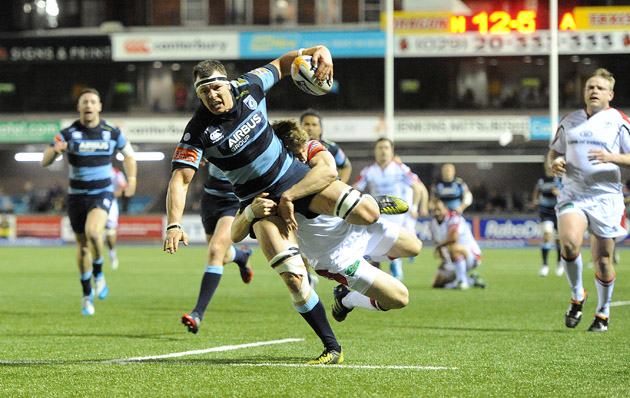Here's what has been going down in Wales over the last month...
One problem down, one to go
The furore over the future of European rugby seems all but over. April should see the announcement of a new tournament, with the desired changes to qualification, remuneration and a solution to the impasse over television rights. And whilst everyone in France, Italy, Ireland, England and Scotland can breathe a sigh of relief, you may still hear groans in Wales. The European issues have only ever been half of the problem in Wales. Welsh rugby’s civil war is still raging to the point that it could soon rival the medieval ‘War of the Roses’. This is the ‘War of the Daffodils’.
Welsh rugby still has no long-term participation agreement and relations between the Welsh Rugby Union and the Regions are still at such a low that meetings between both should be held on the Mariana Trench. All may soon be well in Europe. It isn’t in Wales.
Cardiff Blues roll over Ulster
Cardiff Blues stunned Ulster with a 28 – 23 victory at the soon to be named BT Sport Cardiff Arms Park. It would be fair to say that the result stunned the Cardiff Blues supporters as much as it did the Ulster fans. It was a fine victory against a full strength Ulster and provided the team with a season highlight to add to their victory against Toulon. Blues were competitive in all aspects of the game. They secured 50% of the ball, 50% of the territory and the lineout ran at a 91%. The confident team performance was complemented by some equally confident individual performances.
Gareth Davies’ goal kicking was at a test standard eight from eight. Corey Allen delivered a reassuring balance of carrying and defence. Alex Cuthbert led the clean break stats for both teams and also demonstrated a slight of hand that we rarely see from the giant winger. His reverse ‘cat flap’, to set up Robin Copeland’s try in the 35th minute, was sublime. But by far the stand out player was Josh Navidi. Navidi played like the ‘Predator’. His groundwork was first class as was his role in open play. Navidi led the defenders beaten stat for his team. Dale Macintosh and Paul John will be pleased.
Moffett shows his hand
March saw David Moffett launch his rebirth of Welsh rugby at the Castle Hotel, in Neath, arguably the birthplace of the Welsh Rugby Union. The official launch of the ‘Moffesto’ signalled that Moffett is taking this challenge very seriously after some have questioned his intentions up to this point. Moffett’s so far casual interactions, on social and traditional media, are now backed up with a considered plan and highlight the former WRU CEO’s seemingly genuine desire to once again secure a seat on the board. But whilst the document certainly signals the seriousness with which Moffett is taking the task, just how seriously the document has been received still remains to be seen. As of yet there has been no comment from Regional Rugby Wales or, perhaps less surprisingly, the Welsh Rugby Union itself. However, just two votes from 320 unions clubs could see the ‘seriousness’ of Moffett’s challenge ramp up significantly.
Bristol – the new threat
The West of England has long been a threat to Welsh rugby – principally from the cloudy 6%+ cider which has caught many a player off guard. However the threat no longer comes from apples but dough. Bristol RFC have got loads of it.
Many may view an English championship team of limited importance when faced with the colossal financial might of the Top 14 and Aviva giants but they would be wrong. Bristol is a Championship team with Premiership money. March saw the announcement that Ryan Jones will join the club and link up with fellow Welshmen Dwayne Peel and Matthew Morgan. However, the threat of Bristol is more than financial. Their proximity to Wales is equally important.
Whilst cash features high on a player’s consideration list when moving clubs, so too lifestyle. Playing in Bristol doesn’t involve moving house or uprooting your children. A contract in Bristol doesn’t involve annoying flights back and forth to France. You could cycle from Bristol to Cardiff in three and half hours. If Bristol are promoted they will become a worryingly attractive proposition for Welsh players.
Is ‘live’ rugby hard to watch?
The past month, in Wales, has seen much debate into the reasons why Regional Rugby cannot attract supporters to their grounds.
Uncompetitive teams, poor scheduling and a lack of ‘identity’ are often touted as core reasons for the failure to attract supporters into the ground. But there may be a wider reason for the malaise. Rugby is becoming a hard game to watch from the stands. It is becoming an increasingly ‘micro’ game where close-up intricacies dominate the game. Modern rugby is dominated by moments that can’t always be seen from the stands. Slipped binds in the scrum, hands in the ruck, illegal entry at the ruck and collapsed mauls all require television to fully appreciate them. Watching a game live in the stadium, whilst being a wonderful experience, almost always requires a second viewing at home, on the TV, to fully appreciate the context of the whole game. Falling attendances are not just an issue in Wales.
In 2006, South Africa posted an average Super Rugby crowd of 34,000, Australia 24,000 and New Zealand 22,000. By 2012, those numbers dropped – South Africa was down to 28,000, Australia 20,000 and New Zealand 16,000. Yet from 2010-2011 New Zealand’s Super Rugby TV viewing figures leapt to 10 million – a 32% increase on 2011. I’m not suggesting that rugby’s ‘micro’ nature is the sole reason for falling attendances in regional rugby in Wales as it isn’t. However rugby’s obsession with the ‘micro’ aspects of the game, rather than the stadium friendly ‘macro’ components is worthy of discussion.








